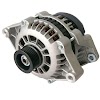Nuclear Reactor main parts and their functions
Nuclear reaction is the heart of the nuclear power station, where tremendous amount of heat energy is released as a result of nuclear fission of radio-active materials. This heat is utilized to heat the coolant which in turn generates steam/ nuclear reactor consists of the following basic components which are show in
1. Fuel: The fuels generally used in the reactor are 92U235, 94PU239 and 92U239, 92U238, 90TH232 etc. fuel should be so shaped and located in the reactor such that uniform heat should be produced.
2. Reactor core: It is built of graphite bricks, having channels machined thought them. The core is cylindrical in shape and is placed on a large pressure vessel totally enclosed in a thick walled shielding structure of concrete about 2-3 meters thick. The size of the core is, just sufficient to maintain a chain reaction.
3. Moderator: The purpose of moderator is to moderator is to moderate or slow down neutron speed to a value that increases the probability of fission process. Graphite, Heavy water are most commonly used as moderator. Beryllium and ordinary water can also be used as moderator with natural uranium and enriched uranium respectively. It is the central part of the core.
4. Shielding : The purpose of shielding is to prevent the escape or leak of neutrons (fast and slow), a,b particles and y-rays from reactor as these radiations are harmful to human being. Lead iron or concrete shields are used for this purpose.
5. Control Rods: The control of chain reaction inside the reactor is obtained by inserting control rods into the reaction core. The control rods are made with cadmium (or boron), because cadmium is a strong neutron absorber. When control rods are pushed into the core they absorb some of the neutron and hence few neutrons are available for chain reaction. However, when they are pulled out from the reactor core more neutrons are available for fission process. Therefore by pulling out and pushing them in supply of neutrons for fission purpose can be regulated. These rods are in practice suspended from the top of the reaction in the channel of core, and are lowered or raised by special mechanism according to the load requirements.
6. Reflection: In order to avoid the leakage or escape of neutrons from the reactor it is essential to surround the reactor with material acting as a reflector. As the name indicates, the function of reflector is to reflect as many leakage neutrons as possible back into the reactor. The reflector gets heated due to collision of neutrons with its atoms, hence cooling is essential the materials used for reflectors is same as that of the materials used for moderator i.e Graphite, Heavy water.
7. Coolant: A coolant is a medium through which heat produced in the reactor is transferred to the heat exchanger for further utilization in power generation. Liquid sodium is generally used as coolant. When water is used as a coolant it takes up heat and gets converted into steam in the reactor itself, which is directly used to drive the turbine. The commonly used coolants are gas (Co2, air, hydrogen, helium) and some organic liquids.
8. Reactor Vessel: The Reactor vessel encloses the reactor core, reflector and shield. It is a strong walled container genrally cylindrical in shap and provides the exit for passage of coolant. It should withstand high pressures. The holes are provided at the top of the vessel to insert the control rods.











0 Comments